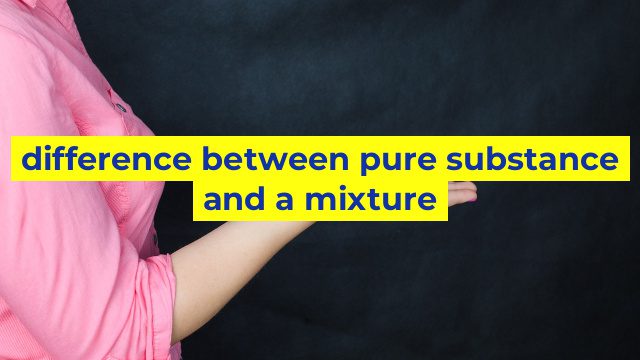The Difference between Pure Substance and a Mixture
What is a Pure Substance?
A pure substance is a type of matter that has a fixed chemical composition and physical properties. It cannot be separated into smaller components using physical methods. Pure substances are classified into two categories, substances that are made up of only one type of atom and substances made up of molecules of the same type.
One example of a pure substance is water (H2O), which is a compound made up of two hydrogen atoms and one oxygen atom. The chemical properties of water are constant for all samples of the substance. Another example is diamond, which is an allotrope of carbon. It is made up of only carbon atoms arranged in a unique lattice structure.
What is a Mixture?
A mixture is a combination of two or more pure substances that are physically combined. The components of a mixture can be separated using physical methods, such as distillation, chromatography, or filtration. Mixtures can be homogeneous, meaning that the components are evenly distributed throughout the mixture, or they can be heterogeneous, meaning that the components are not evenly distributed.
One example of a homogeneous mixture is saltwater, which is made up of salt (NaCl) and water (H2O). The components are evenly distributed throughout the mixture, and their chemical properties remain constant. Another example is air, which is a mixture of nitrogen, oxygen, and other gases. These components are distributed evenly throughout the atmosphere.
The Key Differences between Pure Substances and Mixtures
The main difference between pure substances and mixtures is their composition. Pure substances are made up of only one type of atom or molecule and have a fixed chemical and physical property. On the other hand, mixtures are made up of two or more pure substances and can be separated using physical methods.
Another difference is that pure substances have a specific melting and boiling point, while mixtures have a range of melting and boiling points depending on their components’ physical properties.
Finally, pure substances cannot be separated into smaller components using physical methods, while mixtures can be separated using physical methods.
In conclusion, understanding the difference between pure substances and mixtures is essential in chemistry. Pure substances have a fixed composition, while mixtures are made up of multiple components that can be separated using physical methods. Knowing these distinctions can help scientists develop better ways to organize and classify matter.
Table difference between pure substance and a mixture
| Property | Pure Substance | Mixture |
|---|---|---|
| Definition | A substance composed of only one type of particle | A combination of two or more substances that are not chemically bonded |
| Composition | Fixed and uniform throughout the substance | Varies and is not uniform throughout the mixture |
| Physical Properties | Distinct and specific to the substance | The physical properties of each individual substance in the mixture are maintained |
| Chemical Properties | Unique and specific to the substance | The chemical properties of each individual substance in the mixture are maintained |
| Separation | Difficult to separate into its constituent parts | Can be separated into its individual components through physical or chemical means |
